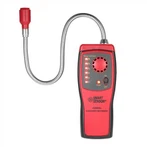Getting to Know the Digital Multimeter's Technical Indicators
Display digits and display characteristics
The display digits of a digital multimeter are usually between 31/2 and 81/2 digits. There are two principles for determining the display digits of a digital instrument:
One is that the digits that can display all numbers from 0-9 are integer digits;
The second is that the value of the fractional digit is expressed as the numerator of the highest digit in the displayed value. When measured at full range, the value is 2000, which indicates that the instrument has 3 integer digits. The numerator of the fractional digit is 1 and the denominator is 2, hence it is called 31/2 digit and read as "three and a half digits". The highest digit can only display 0 or 1 (0 is usually not displayed).
The high digit of a 32/3-digit (pronounced as "three and two-thirds") digital multimeter can only display numbers from 0 to 2, so the maximum displayed value is ± 2999. In the same situation, it has a 50% higher limit than a 31/2-digit digital multimeter, especially valuable for measuring 380V AC voltage.
For example, when measuring grid voltage with a digital multimeter, the high digit of a regular 31/2-digit digital multimeter can only be 0 or 1. If measuring 220V or 380V grid voltage, only three digits can be used for display, and the resolution of this range is only 1V.
In contrast, using a 33/4-digit digital multimeter to measure grid voltage, the high bits can display 0-3, allowing for a four digit display with a resolution of 0.1V, which is the same as the resolution of a 41/2-digit digital multimeter.
Universal digital multimeters generally belong to handheld multimeters with 31/2 digit displays, while 41/2 and 51/2 digit (below 6 digits) digital multimeters are divided into handheld and desktop types. Most multimeters with 61/2 or more digits belong to desktop digital multimeters.
The digital multimeter adopts advanced digital display technology, with clear and intuitive display and accurate reading. It can ensure the objectivity of readings and conform to people's reading habits, which can shorten the reading or recording time. These advantages are not possessed by traditional analog (i.e. pointer) multimeters.
Accuracy (precision)
The accuracy of a digital multimeter is the combination of systematic and random errors in the measurement results. It represents the degree of consistency between the measured value and the true value, and also reflects the size of the measurement error. Generally speaking, the higher the accuracy, the smaller the measurement error, and vice versa.
There are three ways to express accuracy, as follows:
Accuracy=± (a% RDG+b% FS) (2.2.1)
Accuracy=± (a% RDG+n words) (2.2.2)
Accuracy=± (a% RDG+b% FS+n words) (2.2.3)
In equation (2.2.1), RDG is the read value (i.e. display value), FS represents the full-scale value, the first term in parentheses represents the combined error of A/D converters and functional converters (such as voltage dividers, splitters, true RMS converters), and the latter term is the error caused by digital processing.
In equation (2.2.2), n is the change in quantization error reflected in the last digit. If the error of n words is converted into a percentage of the full scale, it becomes equation (2.2.1). Equation (2.2.3) is quite unique, as some manufacturers use this expression, with one of the last two terms representing errors introduced by other environments or functions.
The accuracy of a digital multimeter is much better than that of an analog pointer multimeter. Taking the accuracy index of measuring the basic range of DC voltage as an example, it can reach ± 0.5% for 3 and a half bits, 0.03% for 4 and a half bits, etc.






